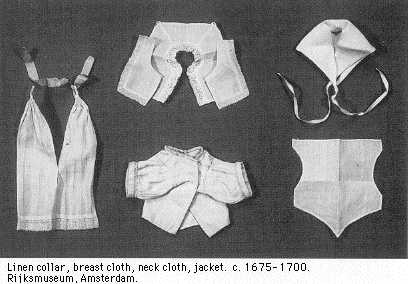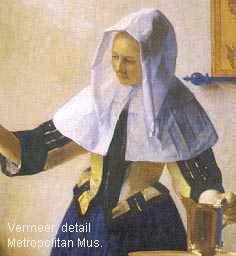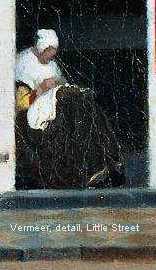

 Three
white caps 'Drye [drie] witte kappen', in the great
Hall ("groote zael") Room I. The cap is a head covering.
Three
white caps 'Drye [drie] witte kappen', in the great
Hall ("groote zael") Room I. The cap is a head covering.
A term widely used for a head cap in the 17th century was "kaper" in Amsterdam and "kap" or "hooftdoek" in Delft.
Two night shoulder shirts 'Twee nachtmantels' in the great Hall ("groote zael") Room I.
In the Vermeer painting 'Woman with Pitcher', we see a night shoulder shirt "nachtmantel" or nightrail "nachthalsdoek". It was a garment which was worn in bed, and during the process of getting dressed in the morning. It also doubled as an informal garment during the daytime. (Marieke de Winkel*, 1998, p. 329).
The daytime use of a nightrail is visible in the Woman with Water Jug, Metropolitan Museum of Art, New York City and in the small woman in the door opening of The Little Street, Rijksmuseum, Amsterdam.
 Note
: This object was part of the Vermeer-inventory as listed by the
clerk working for Delft notary public J. van Veen. He made this list
on February 29, 1676, in the Thins/Vermeer home located on Oude
Langendijk on the corner of Molenpoort. The painter Johannes Vermeer
had died there at the end of December 1675. His widow Catherina and
their eleven children still lived there with her mother Maria
Thins.
Note
: This object was part of the Vermeer-inventory as listed by the
clerk working for Delft notary public J. van Veen. He made this list
on February 29, 1676, in the Thins/Vermeer home located on Oude
Langendijk on the corner of Molenpoort. The painter Johannes Vermeer
had died there at the end of December 1675. His widow Catherina and
their eleven children still lived there with her mother Maria
Thins.
The transcription of the 1676 inventory, now in the Delft archives, is based upon its first full publication by A.J.J.M. van Peer, "Drie collecties...", Oud Holland, 1957, pp. 98-103. My additions and explanations are added in square brackets [__]. Dutch terms have been checked against the world's largest language dictionary, the Dictionary of the Dutch Language (Woordenboek der Nederlandsche Taal , or WNT), which was begun by De Vries en Te Winkel in 1882. In 2001 many textile terms were kindly explained by art historian, Marieke de Winkel.
Illustration on top taken from the recently published handbook on Dutch Doll Houses by Jet Pijzel-Dommisse, Het Hollandse pronkpoppenhuis, Interieur en huishouden in de 17de en 18de eeuw, Waanders, Zwolle; Rijksmuseum, Amsterdam, 2000, ill.. 54.
*Marieke de Winkel, 'The Interpretation of Dress in Vermeer's Paintings' in Vermeer Studies, edited by Ivan Gaskell and Michiel Jonker, National Gallery of Art, Washington, DC, 1998, pp. 327-339.
This page forms part of a large encyclopedic site on Vermeer and Delft. Research by Drs. Kees Kaldenbach (email). A full presentation is on view at johannesvermeer.info.
Launched December, 2002; Last update March 2, 2017.
Back to the Welcome page: click Welcome.